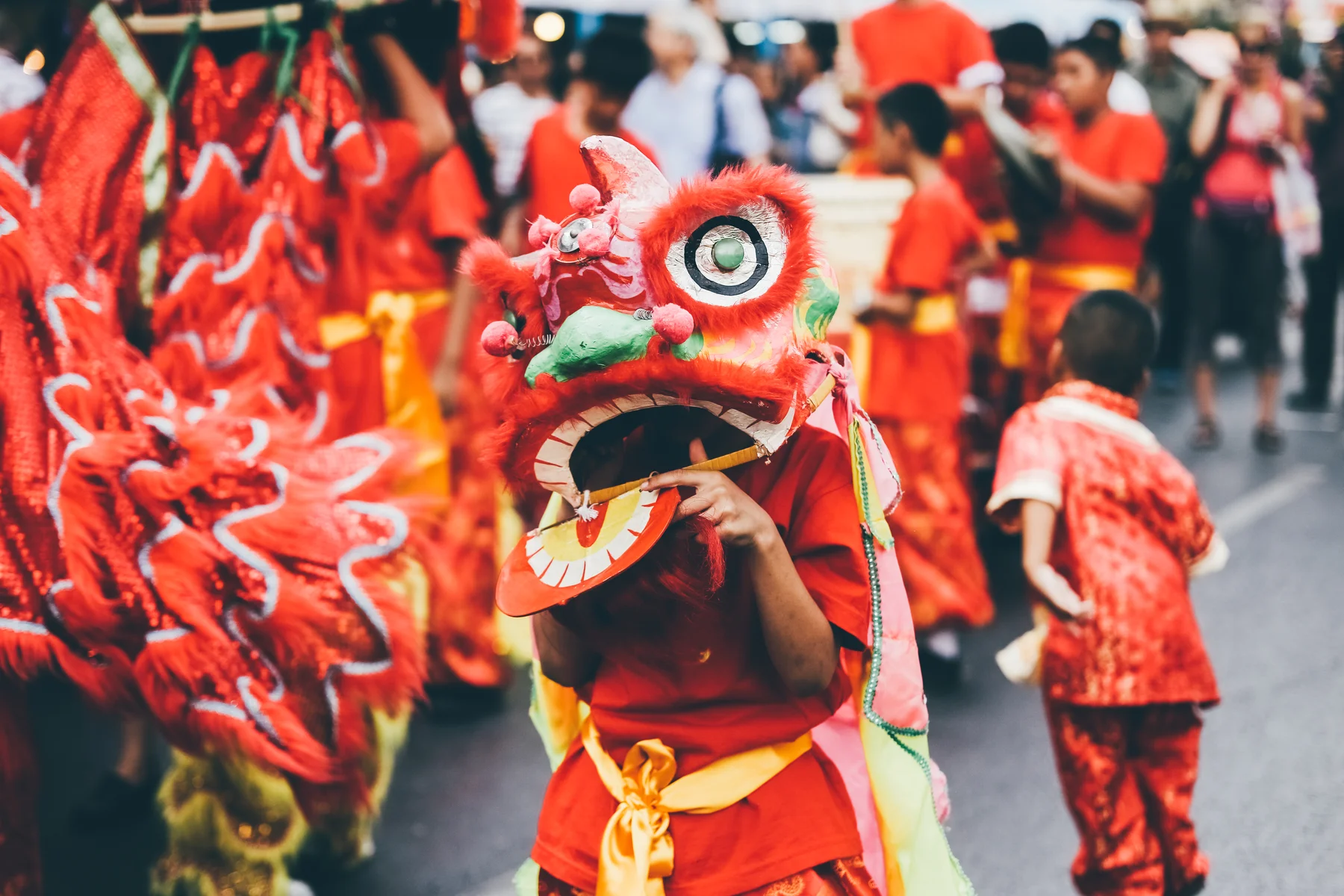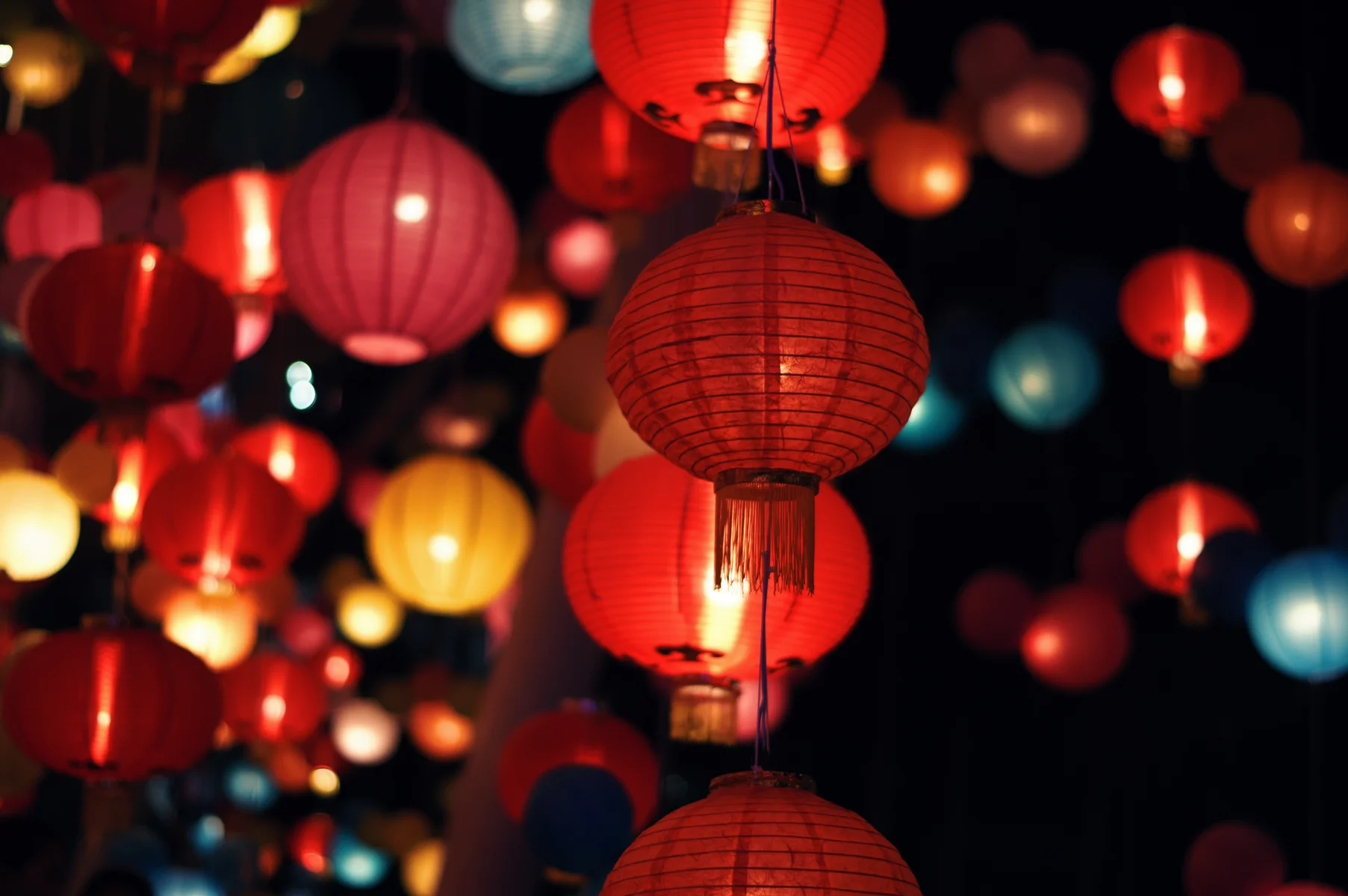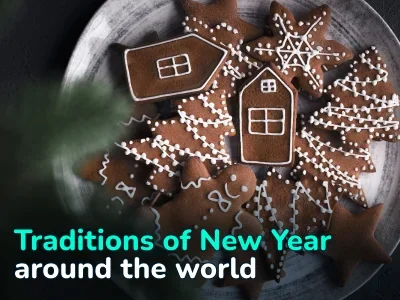
New Year in China: history, traditions, and gifts
Do you want to keep celebrating the New Year? Then it’s worth adding the Chinese New Year to your schedule, following the example of 20% of the world’s population. Read more about New Year in China and its traditions further on.
We recently compiled a list of the most interesting New Year’s traditions around the world. But some countries celebrate this holiday on a different schedule. For example, the Chinese New Year, or Lunar New Year, this year (2025) comes as early as Jan.29; Chinese greet it by saying this: 新年快乐 (xīn nián kuài lè). We have collected the most important information about this celebration: from customs and attributes to traditional dishes and gifts.
Chinese New Year: a brief history
For China, 2025 will be the 4723th year of the current calendar. The counting goes back to when the country was led by the legendary Emperor Huangdi. At that time, it was an occasion to celebrate the harvest and worship the gods. Today it is more of a family holiday, with everyone going to their families and celebrating the new year together.
It is worth noting that the Chinese also celebrate the New Year according to the Gregorian calendar that we are used to, but in a modest way. However, the main holiday for the Chinese people is the Lunar New Year, or Spring Festival (Chunjie); in Chinese, it is spelled 春节. By the way, the name is accurate: the first signs of spring arrive in China in late January or early February.
Local legend says that on the day of the beginning of the new year according to the lunar calendar, Nian — a huge monster with a long horned head who devours all the supplies of people — comes out of the sea. It is believed that in the past, when the monster came, the people of the coastal villages fled their homes in fear and hid in caves.
This went on until an old man came up with various amulets against the monster: he began sticking red papers on all the doors, burning bamboo, and dressing himself in red clothes. The nanny was frightened of these attributes, and never came again. Therefore, these traditions are still observed by the Chinese to this day.
When the Chinese New Year begins?
The date of the Chinese New Year is determined by the lunar calendar, and it changes every year. The first day of the new year always falls on the new moon between Jan. 21 and Feb. 20.
In 2025, the Chinese New Year will come on Jan. 29, and it will be celebrated for 16 days, until Feb.12. It is, by the way, the longest holiday of East Asian countries.
Each day has its own meaning and purpose. See a detailed calendar with dates and events here.
Chinese New Year: «totem» animals
Each new year in the Chinese calendar is associated with a specific animal sign. There are 12 animals in the Chinese zodiac calendar (oriental horoscope).
Here are all 12 zodiac signs:
- Rat
- Bull
- Tiger
- Rabbit
- Dragon
- Snake
- Horse
- Goat
- Monkey
- Rooster
- Dog
- Pig
Since this cycle repeats every 12 years, it’s easy to tell if this is your year — just check if your age is a multiple of 12.
The colors and elements also change: yellow, white, green, red; earth, metal, water, wood, fire. Each combination of sign, element, and color in the Eastern horoscope is repeated once every 60 years.
As for the “totem” animal of 2025, it will be the Wood Snake. In Chinese culture, it is a symbol of wisdom and generosity. This is predicted to be the year when overdue conflicts and problems should be resolved.
What is the Character of People Born in the Year of the Snake
Snake occupies the sixth place in the Chinese zodiacal cycle and symbolizes wisdom, strategic thinking, and exceptional intuition. Representatives of this sign are born analysts and subtle communicators, able to find non-standard solutions even in the most complex situations.
Despite the potential difficulties that may arise in the year of the Snake, these trials often become a catalyst for personal growth and the acquisition of life wisdom. Snakes are adept at extracting valuable lessons from the most difficult situations, turning challenges into opportunities for self-development.
Distinctive traits of people born in the year of the Snake include innate diplomacy, the ability to analyze information in depth, and the rare gift of foresight. They are inclined to a philosophical way of thinking and are able to keep secrets, which makes them reliable friends and indispensable advisors.
In the professional sphere, Snakes show themselves as talented strategists, able to calculate several moves ahead. Their intuition and analytical mind allow them to achieve impressive results in business, diplomacy, science, and creative professions.
Lucky Symbols and Omens Associated with the Wood Snake
In Chinese astrology, there is a whole set of favorable and unfavorable elements for Snakes. The lucky ones include the numbers 1 and 8, the colors red and black, as well as western and southern directions. At the same time, you should avoid pink, purple, numbers 0 and 5, as well as the eastern direction.
In love relationships, Snakes show themselves as passionate and subtle natures. Despite their mysteriousness, they are able to become very faithful partners. However, they require similar devotion from their chosen ones and can be suspicious.
The most harmonious unions Snake traditionally forms with Rooster, Bull, and Monkey. Relationships with the Rooster resemble the meeting of fire and water — they seem contradictory, but incredibly attractive. With the Bull, they create a quiet and safe harbor of understanding. And with the Monkey form an intellectual tandem based on deep mutual respect.
In the professional sphere, Snakes are especially successful in creative and analytical fields. The best career trajectories include the professions of an investment advisor, psychologist, stylist, social media influencer, and artist. That said, monotonous professions that require long periods of concentration and teamwork are contraindicated for them.
Health for Snakes is a somewhat vulnerable area. Because of the tendency to a sedentary lifestyle and creative introversion, they are recommended to move more and diversify physical activity.
An interesting peculiarity — in their own year (Ben Ming Nian) representatives of the Snake sign are recommended to wear red elements of clothing as a hedge against possible bad luck.

How to celebrate Chinese New Year?
The Chinese New Year is associated with many traditions and rituals. We will tell you about the most important of them.
- The holiday begins with the mass launching of fireworks and the lighting of incense. The louder it is, the better.
- On New Year’s Eve, many people gather to pray for happiness and good luck at the famous Longhua Temple (located in Shanghai).
- To avoid facing the monster called Nian (we wrote about him above), you should put something tasty at the doorstep.
- Also, the Nian is afraid of the red color. That is why the red color is used everywhere these days. Red paper lanterns are especially popular.
- An indispensable attribute of the Chinese New Year is Nian Fan, a family dinner on the eve of the New Year; it is also called a reunion dinner.
- The folk festivities and spectacular performances are the masthead of the Spring Festival. Dancing figures of lions and dragons, symbols of celebration, appear in the streets at this time.
- The temple fairs (miaohui), which date back to ancient times, are very popular at this time. Now it is more of a secular event with theatrical performances, concerts and tasting delicacies.
- The Chinese New Year should be celebrated in new clothes, and underwear should be red.
- Before the New Year, you should thoroughly clean your house — this way you get rid of unnecessary things and negative energy.
- Chinese new year decorations include blossoming flowers — they symbolize rebirth, as well as prosperity and professional growth.
- By the way, they don’t decorate Christmas trees in China — they collect a money tree. They do it this way: a deep pot is filled with rice, cut branches of the tree are placed in it, and many mon (ancient copper coins) are tied to them.
- Today, on the eve of the Spring Festival in China, it is customary to watch the New Year’s Eve Gala on CCTV. The show begins at 8 p.m. and continues until midnight. In recent years, live broadcasts have also become available on YouTube.
- One does not usually go to bed after dinner so as not to miss out on future happiness.
And here's what you can't do (taboo during the Chinese New Year):
- On New Year’s Eve, you should not wash — you can flush out all your good fortune. For the same reason, you should not cut your hair — you will cut off a part of your prosperity.
- Do not utter negative words. Be careful not to bring misfortune upon yourself and your loved ones in this way.
- Do not break dishes. Break things will reduce your chances of prosperity and good luck.
- Do not clean up. This applies specifically to the celebration itself. Cleaning up or throwing away trash can take away your good fortune.
- Do not use scissors or sharp objects. Sharp objects are believed to impede the flow of wealth and success.
- Do not take loans or go into debt.
- Avoid taking medicines and going to the doctor. This is to avoid falling ill for the whole year. Of course, chronic and serious diseases are an exception.
- Do not quarrel and do not cry. All issues must be resolved peacefully — then the new year will pass in the same manner.
How are Streets and Houses decorated in China for the New Year?
The main color of this holiday is deep red, symbolizing happiness, good luck, and protection from evil spirits.
Paper cutouts “chuan hua”
The centerpieces of the festive decorations are the “chuan hua” paper cutouts. These exquisite ornaments, crafted with great care, are glued to the windows by skilled craftsmen using sticky rice glue. Traditionally, they are made of red paper and contain symbolic images: fish representing abundance, peaches symbolizing longevity, as well as dragons and phoenixes known from folk legends.
Guardian gods “men shen”
An integral part of the décor are paired images of the “men shen” guardian gods. These formidable characters, with distorted faces and weapons in their hands, symbolize powerful protection from evil spirits, guarding the front door.
Calligraphic inscriptions “fu” (happiness)
Calligraphic inscriptions of the character “fu” (福, happiness) are an indispensable element. They are often hung upside down, creating a witty language game: the word “upside down” sounds similar to the word “come”, hinting that good fortune is already here.
Chun lian (春联) festive scrolls
Festive “chun lian” scrolls containing poetic messages are placed on the sides of the entrance doors. Each line should contain the same number of characters, and the rhythm and structure of the scroll should be harmonious.
“Nianhua” (年画) paintings
A special place is occupied by festive “nianhua” paintings. These colorful prints depicting children, women, mythical creatures, and scenes of daily life not only decorate the space but also express the family’s hopes for the coming year.
Plant Decorations
Plant decorations include tangerine trees, gold-colored kumquats, and chrysanthemums. Each of these elements carries the symbolic meaning of prosperity and good luck.
Holiday lanterns
The culmination of the decoration are holiday lanterns of various shapes: from balls to complex compositions in the form of lotuses and dragons. Wishes are often written on them, which are then released into the sky, hoping for their fulfillment.

Food during the Chinese New Year
New Year’s table in China is made abundant so that wealth and good fortune will accompany the next year. Although each region of China has its own customs, there are several common dishes on every table. Here they are:
- Spring Rolls (Chun Juan).
- Chinese dumplings (Jiaozi).
- Longevity noodles (cháng shòu miàn).
- Steamed fish (zhēng yú).
- Steamed chicken (zhēng jī).
- Nian Gao, also known as «rice cake».
A popular drink during the New Year holidays is wine. Regardless of age, every family member should have at least a sip of this drink, as in China it is believed that alcohol can protect against misfortune. During the Spring Festival, tea, popular in the country, takes a back seat.
Сhinese New Year: traditional gifts
The people of China have found a universal and practical solution for New Year’s gifts: they usually give envelopes with money in them. Envelopes are called Hongbao, and they are always red. As for the amount, the main thing is that it must be even. Along with the envelope, they also give tangerines or oranges.
What is interesting, since 2015 there are even digital analogues of such envelopes — the function to send money to personal and public chats was introduced by the Chinese messenger WeChat.
And what should not be given for the Chinese New Year is a watch — it is considered a gift for unhappiness or separation.
FAQ
How to determine the date of the Chinese New Year?
When to celebrate the Chinese New Year 2025?
How long is Chinese New Year?
During the New Year holidays, are the Chinese working?
What year is it in China?
What are the lucky numbers for those born in the year of the Snake?
Which celebrities were born in the Year of the Wood Snake?
What to wear on the Chinese New Year?
What to present for the Chinese New Year?
Where to watch the Chinese New Year?
Author
I am responsible for editorial work. I write expert interviews and guides.
























